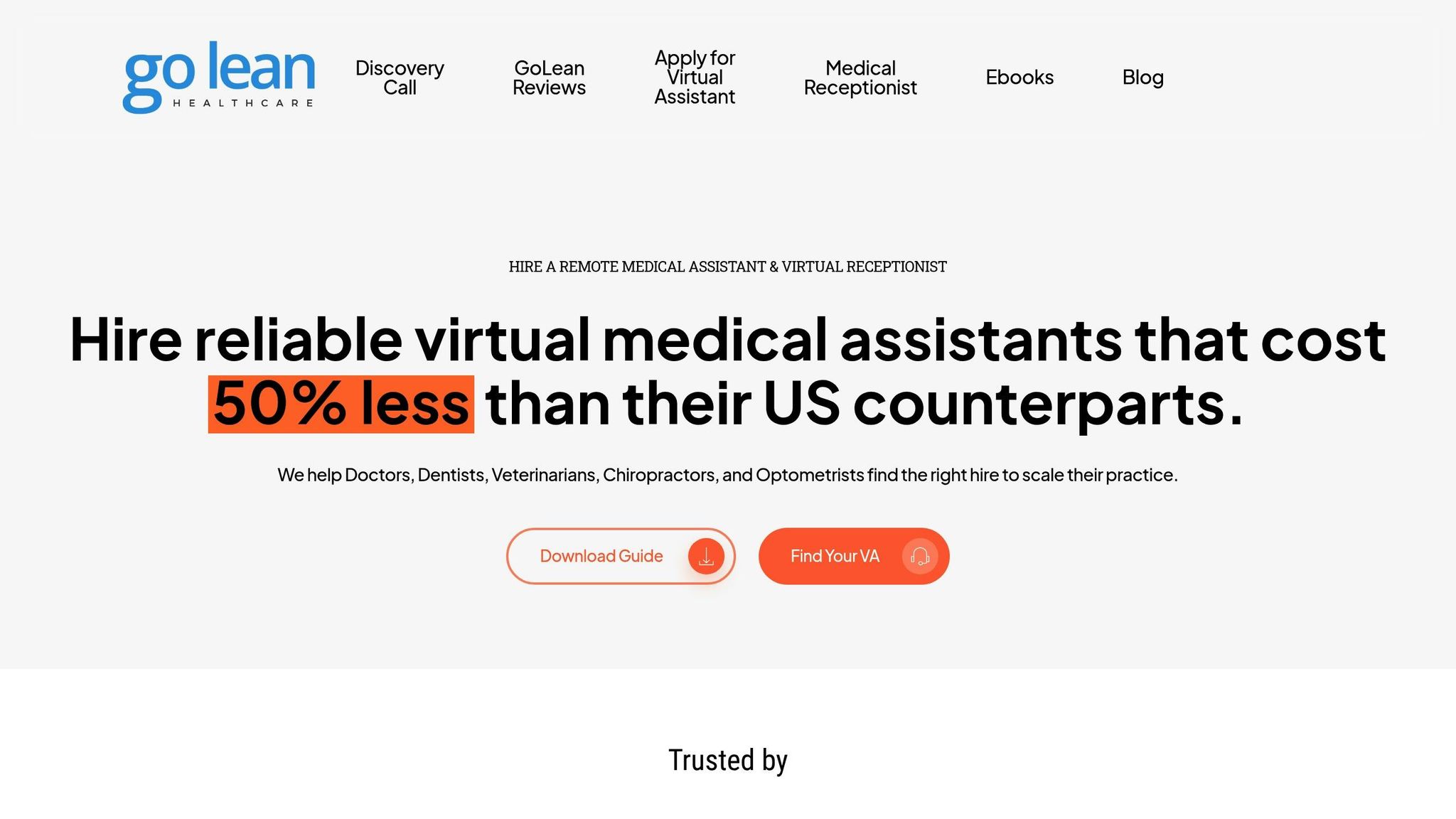Digital patient intake transforms healthcare. It replaces paper forms with online tools, making registration faster, easier, and more accurate for both patients and staff. Practices save time, reduce errors, and improve patient satisfaction by automating tasks like insurance verification and consent management. Virtual medical assistants (VMAs) provide cost-effective support, handling administrative tasks and ensuring smooth operations.
Key Benefits of Remote Patient Intake:
- Saves Time: Automates data entry, insurance checks, and updates to medical records.
- Improves Patient Experience: Mobile-friendly forms, multilingual support, and shorter wait times.
- Enhances Data Security: HIPAA-compliant systems with encryption and role-based access.
- Cost-Effective Staffing: Remote assistants starting at $9/hour handle key tasks like scheduling and communication.
Quick Comparison:
| Feature | Traditional Intake | Digital Intake |
|---|---|---|
| Data Collection | Paper forms, manual entry | Online forms, automated sync |
| Insurance Verification | Manual, time-consuming | Real-time, automated |
| Patient Convenience | Long wait times | Mobile-friendly, pre-visit |
| Cost | Higher staffing costs | Remote assistants, $9/hour |
Switching to digital intake is simple and scalable. Choose HIPAA-compliant software, train staff, and integrate with your EHR system for seamless operations. Ready to modernize your practice? Start with remote patient intake today.
Automate Claims Processing and Patient Intake Forms with AI
Key Components of Digital Patient Intake
A remote patient intake system relies on key integrated features to provide a secure and easy experience for both patients and healthcare providers.
Online Forms and Documents
Online forms play a crucial role in gathering necessary patient information. Here’s a breakdown:
| Form Type | Information Collected |
|---|---|
| Patient Demographics | Personal details, contact information, emergency contacts |
| Medical History | Past conditions, current medications, allergies, surgeries |
| Insurance Information | Policy details, coverage verification data |
| Practice Policies | Acknowledgment of financial responsibility, privacy notices |
Medical Virtual Assistants (MVAs) help streamline this process by updating Electronic Medical Records (EMRs) and sending appointment confirmations. Once the data is collected, the next step involves verifying insurance details.
Insurance Check Process
Digital insurance verification reduces claim rejections by confirming coverage before appointments. This process includes:
- Real-time eligibility checks
- Verification of benefits
- Confirming co-pays and deductibles
- Checking for prior authorization requirements
Virtual assistants handle these tasks to ensure accurate insurance details are recorded, helping minimize denied claims and ensuring smooth transitions into the next steps.
Patient Consent Management
Managing patient consent in a HIPAA-compliant manner is essential for remote intake. Practices must securely handle:
- Treatment consent forms
- Acknowledgments of privacy policies
- Authorizations for information release
- Telehealth consent documentation
Once consent is obtained, the data is promptly updated in the patient’s Electronic Health Records (EHR).
EHR Connection Requirements
A strong connection between intake forms and EHR systems is key to smooth practice operations. This connection allows for:
- Automatic data transfer, reducing manual entry and errors
- Real-time updates to patient records
- Secure information sharing throughout the care process
- Compliance with HIPAA data management standards
With the right EHR integration, patient information moves efficiently from intake to the care process, ensuring security and compliance every step of the way.
Advantages of Digital Patient Intake
Time and Cost Savings
Switching to digital intake systems can significantly cut down on administrative tasks. Automating processes like data entry not only saves time but also reduces operational costs. With fewer manual tasks, staff can focus more on patient care. Plus, these systems enhance the overall experience for patients by making interactions smoother and more efficient.
Patient Convenience Features
Digital intake offers a range of features designed for patient convenience. Mobile-friendly forms and automated reminders allow patients to complete paperwork before their visit, all from the comfort of their home. Multi-language support ensures that these tools are accessible to individuals from diverse backgrounds.
"I love how our GoLean VA just gets things done… I never have to worry about a patient getting overlooked again." – Dr. Saska Sookra Winslow, LifeStream Family Medicine [1]
Data Security Standards
Beyond efficiency, digital intake systems prioritize strong data security, which helps build patient trust while meeting HIPAA compliance requirements. Protecting sensitive information is essential for maintaining confidence and ensuring smooth operations.
Here are some key security measures:
| Security Measure | Purpose |
|---|---|
| Encrypted Data Transfer | Keeps information secure during transmission |
| Role-based Access Control | Restricts data access to authorized personnel |
| Audit Trail Tracking | Tracks interactions for accountability |
| Automated Backup Systems | Prevents data loss through regular backups |
| Multi-factor Authentication | Adds an extra layer of security beyond passwords |
"My VA has become a valuable part of my business. Her sensitivity and care for patient data have earned my utmost trust. I love her work ethic, and we get more done in a day because she’s around." – Dr. Marissa Toussaint, Anise Medical [1]
To ensure data security, healthcare practices should provide thorough HIPAA training, regularly update security protocols, monitor access logs, secure Business Associate Agreements (BAA), and conduct routine security assessments.
sbb-itb-109dad4
Setting Up Digital Patient Intake
Review Current Process
Start by examining your current workflow. Identify each step in the registration process, including paperwork, manual data entry, and any recurring bottlenecks or errors. Make a list of key needs, such as:
- How many patients you see daily
- The types of forms you use most often
- Your insurance verification process
- Common communication issues
- How tasks are divided among staff
Choose Software Solutions
When picking digital intake software, ensure it complies with HIPAA regulations and integrates smoothly with your existing Electronic Health Record (EHR) system. Look for software with features like:
| Feature | Purpose |
|---|---|
| Multi-device Compatibility | Access on phones, tablets, and more |
| Document Management | Organize forms and records |
| Insurance Verification | Automate eligibility checks |
| Language Support | Offer forms in multiple languages |
| EHR Integration | Sync with your current systems |
The right software can streamline your process and improve both staff and patient experiences.
Staff and Patient Training
Training is key to making the transition smooth. Focus on these areas during training sessions:
- HIPAA compliance and privacy rules
- How to navigate the EMR system
- Protecting patient data
- Cultural sensitivity and awareness
- Bilingual communication skills, if needed
Technical Setup Steps
Here’s how to set up your system effectively:
1. Infrastructure Assessment
Check your current setup, including internet speed, hardware capabilities, and security measures, to ensure everything is ready.
2. System Integration
Collaborate with your IT team or software provider to connect your digital intake platform with your existing systems, especially your EHR.
3. Security Configuration
Establish role-based access controls, enable encryption, and set up backup systems to keep patient data secure.
Performance Tracking
Keep an eye on how well your system is working by tracking these metrics:
- How many patients complete digital forms
- The average time it takes to complete the intake process
- Time saved by staff on administrative work
- Fewer errors in patient records
- Patient satisfaction scores
Use this data to fine-tune your intake system and make improvements as needed.
GoLean‘s Patient Intake Support
GoLean brings efficiency to patient intake processes by combining digital tools with specialized remote staff support.
Remote Staff Tasks
Adding remote staff to your digital intake system makes everything smoother. GoLean’s HIPAA-certified medical virtual assistants (MVAs) take care of key tasks, such as:
| Task Category | Specific Responsibilities |
|---|---|
| Documentation | Updating EMRs, processing forms, managing records |
| Insurance | Verifying eligibility, checking benefits |
| Communication | Scheduling appointments, sending reminders, confirmations |
| Prior Authorization | Handling requests and follow-ups |
| Patient Support | Answering calls, managing inquiries |
These MVAs are ready to work immediately, bringing expertise in EMR systems and full HIPAA compliance. Dr. Venkata Aligeti highlights their "plug-and-play" readiness.
Spanish Language Services
GoLean also offers bilingual support to make sure all patients feel included. Their Spanish-speaking MVAs help with:
- Completing forms accurately
- Explaining medical instructions clearly
- Ensuring culturally sensitive patient interactions
- Following compliant documentation practices
This service ensures smooth communication and support for Spanish-speaking patients.
Cost-Effective Staffing
GoLean keeps staffing affordable without compromising quality. At just $9 per hour, their HIPAA-compliant virtual assistants offer expertise in EMR systems and bilingual services.
"My GoLean VA is my savior." – Dr. Marissa Toussaint, Anise Medical [1]
What’s included:
- HIPAA-compliant virtual assistants
- EMR system proficiency
- Business Associate Agreement (BAA)
- Comprehensive administrative support
- Bilingual capabilities when needed
"My VA is a team player!" – Dr. Saska Sookra, LifeStream Family Medicine [1]
"Our VA is an asset to our team." – Dr. Giriraj Sharma, Sharma Facial Plastic Surgery [1]
Conclusion
Digital patient intake systems are reshaping healthcare by improving efficiency and patient care. Remote solutions offer clear advantages for streamlining operations. Here’s a breakdown of the key factors to ensure a smooth transition to digital intake.
Summary Points
Digital patient intake systems, combined with virtual medical assistants, provide a strong framework for modern healthcare practices. Studies show these systems can cut costs by up to 50% compared to traditional staffing methods [1], all while maintaining quality care and operational efficiency.
Key focus areas for success include:
- Technology Integration: Choose software that connects seamlessly with EMR systems and complies with HIPAA regulations.
- Staff Optimization: Assign administrative tasks to remote medical assistants, freeing in-house staff to focus on patient care.
- Patient Experience: Improve service with bilingual support and quick response times.
- Cost Management: Save significantly with virtual assistance starting at just $9 per hour [1].
The table below highlights the main considerations for each focus area:
| Focus Area | Key Considerations |
|---|---|
| Technology | EMR integration, HIPAA compliance, digital forms |
| Training | Staff onboarding, patient education, system usage |
| Support | Bilingual capabilities, administrative assistance |
| Monitoring | Performance tracking, patient satisfaction metrics |




